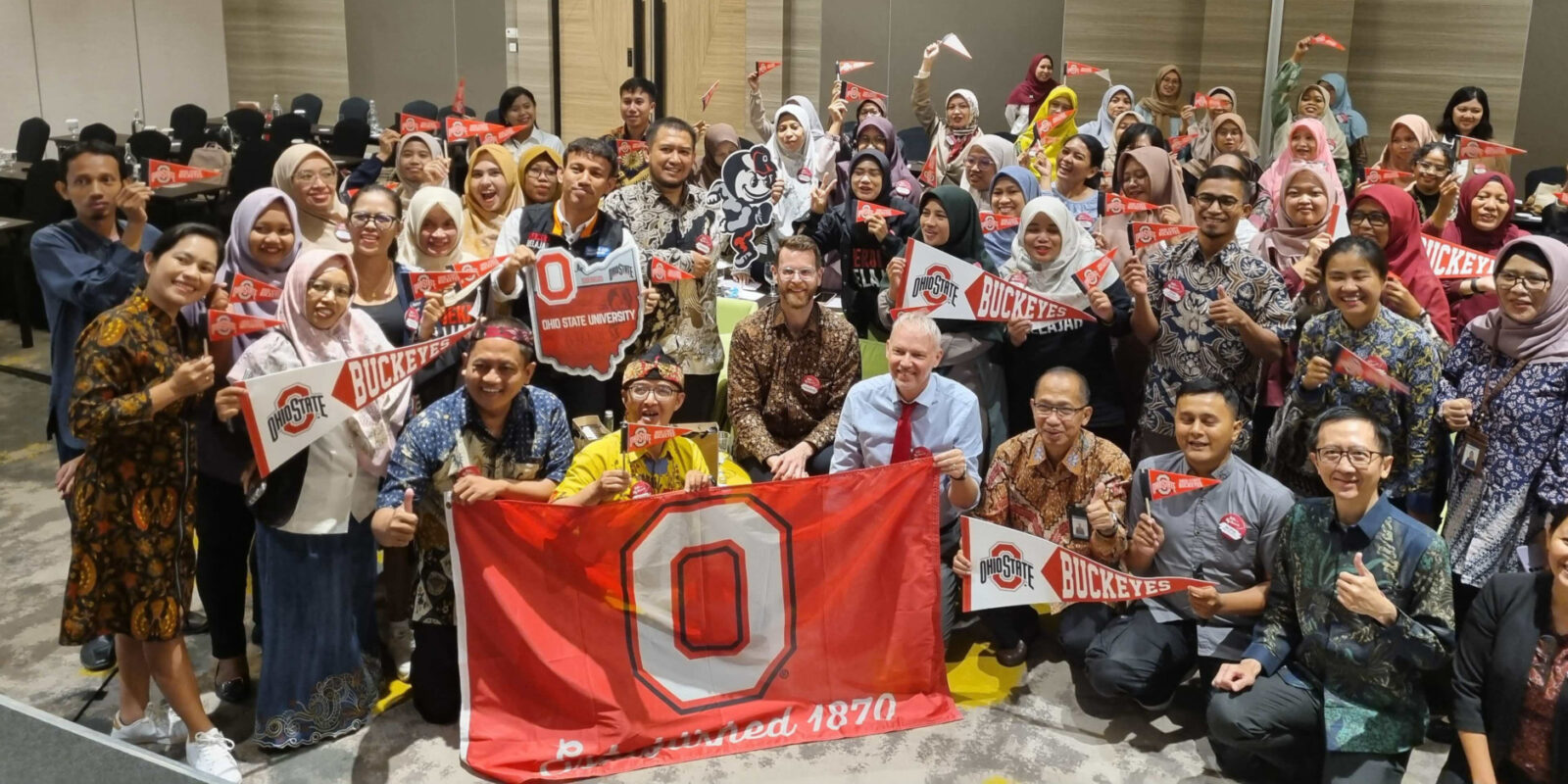In the last few years, we’ve learned some valuable truths about human connections. When necessary, community can be achieved via the internet and two-dimensional computer screens. But some finer aspects of social engagement get lost in the process.
So, when the college’s Buckeye Language Education Resource Center (BuckLER) needed to, it used a hybrid format in 2023 to train elementary teachers in Indonesia to teach English to children in grades one through six.
Professors Peter Sayer and Francis Troyan, and Ivan Stefano, director of Intercultural English Language Programs, artfully orchestrated a synchronous, 5-day training across 10,000 miles and 11 time zones.
That meant they taught classes online until midnight in Columbus, while the teachers in Jakarta had started at the first peep of day.
International collaboration feels a tad less international when done across cyberspace. Still, the experience was impactful and also emotional for the teachers. Stefano, who was born in Indonesia but hasn’t lived there for 30 years, found it especially moving. The last day of training brought many participants to tears.
In-person opportunity returns, teachers travel far and wide

But in July, the team called BuckLER traveled all those miles to do the training in person. It is one of several ways the college has rebounded from pandemic-era travel restrictions to lean into its commitment to global engagement. Other faculty and students this year engaged with universities and communities from Braga, Portugal to Tsukuba, Japan.
Collaborating with people from diverse cultures changes perspectives, enhances understanding and fosters deep scholarly knowledge at home and abroad. Nothing achieves that better than “being there” — immersed in place and time in ways that redefine mindsets.
More than 600 teachers from across the archipelago nation applied to be trained by the BuckLER faculty. A micro-credential training, it is sponsored by Indonesia’s Ministry of Education, Culture, Research and Technology.
“Only 60 people were selected,” Stefano said. “So, it was very competitive.”
Diverse environments, school resources
The participants, all Indonesian, came from vastly different environments.
“There’s this huge disparity in the resources that the teachers from the city have versus the teachers that are from the very far-flung islands,” Troyan said.
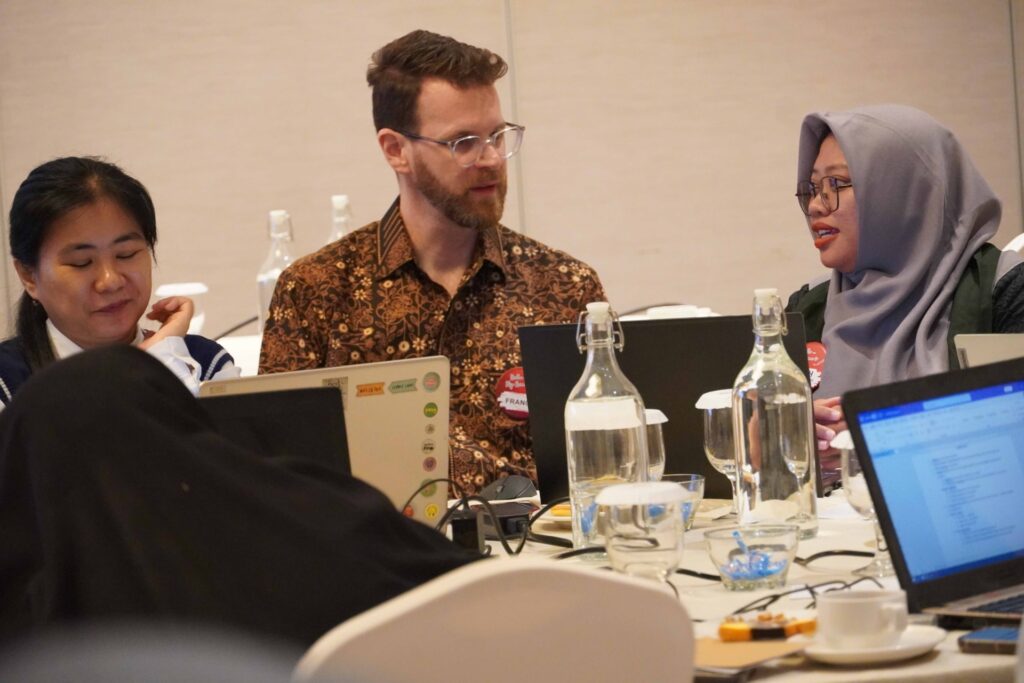
Teachers in the country’s larger cities enjoy transportation systems, educational technology and modern classrooms. Those on remote islands might have no internet or have electricity for only a few hours a day. Their students might come to class barefoot.
One teacher climbed a mountain to reach cell service just so she could respond to her acceptance letter for the training.
“The teachers are the ones in the battlefield, and I am not there,” said Yuseva Iswandari, who earned her PhD in foreign, second and multilingual language education from the college in May. She returned to her faculty position at Universitas Sanata Dharma in Yogyakarta, Indonesia, then helped her former Ohio State faculty mentors train in July.
“One of the teachers coming from the very eastern part of Indonesia, she has to take a helicopter…” Iswandari said. “Then she has to continue riding a motorcycle for an hour. And then she has to continue crossing the river by a small boat to be able to get to the school.”
Speaking different languages, united learning English
Indonesia is home to more than 700 living languages — 10% of the world’s total. While the government is working to preserve that linguistic diversity, it decided post-pandemic to teach all children English to make them more globally competitive.
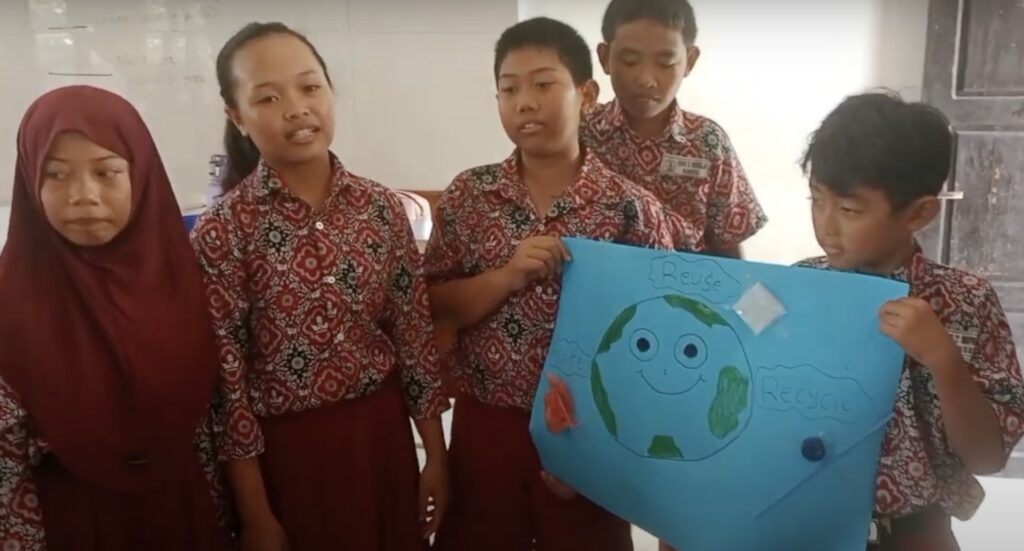
“So those (children) who come from a very, very remote area, grades five and six, they are not able yet to read (Indonesian) well,” Iswandari said. “And just imagine that these teachers have to also teach English to those students.”
The BuckLER team can offer the latest expertise on best practices for teaching foreign languages, but they approach the task with great humility, Sayer said.
“We’re coming to a place where … most of the participants there spoke four or five languages,” he said. “One of the teachers spoke seven languages. Here I’m coming, telling you about how to become multilingual in your country? No. It’s one of the most linguistically diverse places on the whole planet.”
“They’re the experts on their own classrooms and their own communities. How do they process the new ideas in a way that, either they think certain parts might work, where certain parts may not?”
Using backward curriculum design and AI
So, the BuckLER team organized the teachers into groups “Scarlet” and “Gray.” Troyan taught about backward design, in which teachers develop goals first, then design assessments to prioritize goals, and lastly create learning activities that support the outcome.
Sayer taught about how to use artificial intelligence to design integrative learning. He taught how to use total physical response, or body movement and expression, to teach vocabulary and concepts.
Iswandari and Stefano acted as “cultural brokers,” facilitating discussion and helping bridge the gap between American and Indonesian ideas.
“What really happened was they were engaging with and thinking about those practices,” Troyan said, “and thinking about how they would implement it in the spaces and places in communities (where) they do their work.”
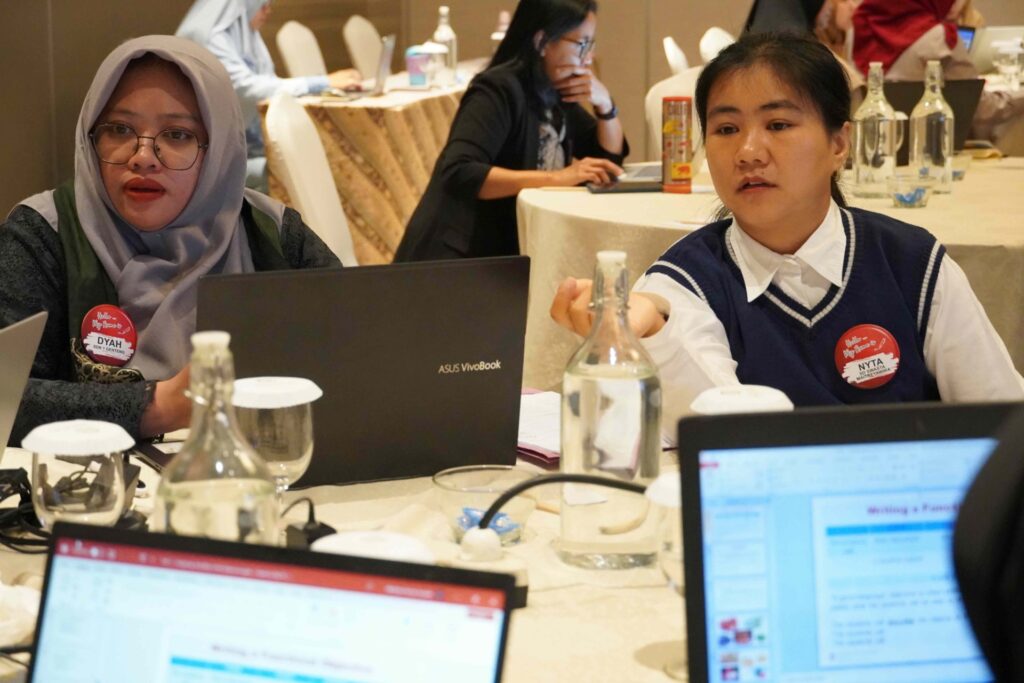
Ethnic dancing sparks connections, pride
As diverse as the participants were, the magic among them sparked almost immediately. While working one morning with the Scarlet group, Stefano heard a commotion going on with Gray.
“I was like, “What are they doing next door?” he said.
“Dancing,” Sayer said. “There was quite a bit of dancing happening … spontaneously, mostly.”
Each morning before class, “Gray” teachers demonstrated their own ethnic dances, then taught the moves to the rest of the group. No one in the room was exempt from learning.
“You couldn’t have done that on Zoom,” Stefano said. “That was unexpected.”
“What really stood out was the community of teachers that was created,” Troyan said. “Their pride, their enthusiasm, their engagement in that space was fantastic to see and watch.”
Respectful teaching leaves lasting impression
And the teachers bonded with the faculty — who astounded them with their respectful philosophies around teaching.
“Dr. Sayer said, ‘We come here not to teach you. We come here to learn with you,’” Iswandari recalled. “Some participants actually wrote those sentences into their final reflections. That left a good mark on their heart.”
In the same vein, Troyan encouraged participants to respect students by teaching in contexts that relate to their lives. English language textbooks, for instance, might feature vocabulary lists of American or European foods that students have never eaten.
“Often textbooks and curricula have tended to be, even still, grammar oriented and list oriented … as opposed to digging into what it really means to use those in a meaningful, interactive way,” Troyan said.
“Instead of just teaching a list of vocabulary about food or a list of vocabulary about family, we think about and develop a meaningful scenario that would happen in the real world.”
In this case, the real world is Indonesian island life, where breakfast might be nasi gudeg — rice and cooked jackfruit — eaten family style, sitting on the floor around a low table. Being able to describe that to an English-speaking visitor or in a video chat or essay puts the learning into a context students can finally relate to.
Teaching and learning English is notoriously difficult, but the shift in pedagogy that the teachers gained was “huge,” Iswandari said. “I can say that they’re so excited; they think that those approaches and strategies actually will help them to improve their teaching.”
Staying connected, sharing success
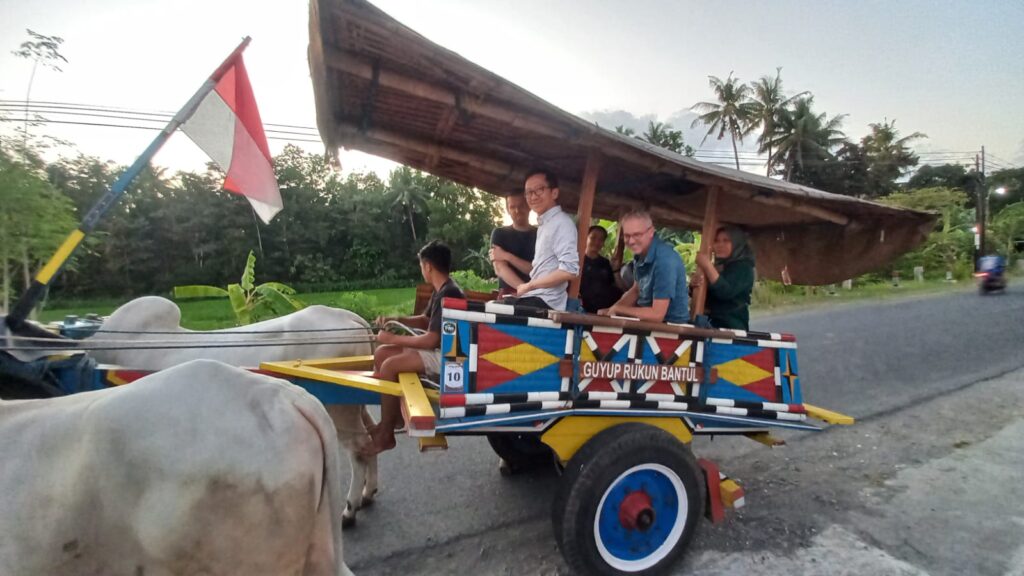
As a last hurrah during the closing ceremony, all 60 teachers and their instructors danced a kind of Indonesian line dance that was “so much fun,” Stefano said.
The teachers, connected in a WhatsApp group, now have a community of practice that they can tap into anytime they need inspiration or help. So, they returned to their provinces to implement the final phase of the course: applying what they learned.
Videos of their instruction, uploaded to YouTube and Carmen Canvas, show the educators’ interpretation of the BuckLER concepts.
One teacher uses total physical response to lead the students in learning movement verbs: “Walking, walking, walking … jump, jump, jump….” The students walk and jump so hard that books fall from a shelf. Everyone giggles.
In remote West Kalimantan, sixth graders hold pictures of Troyan, Sayer, Iswandari and Stefano: “Hi, Mister Sayer!” “Hi, Mr. Troyan!” “Hi, Mister Ivan!” and “Hi, Ms. Yuseva!”
Then the teacher trans-languages as she guides them through a scavenger hunt for shapes in the classroom. One child wants to know if SpongeBob SquarePants counts. He does!
“Have you ever watched the film?” the teacher asks the students.
They have!
“Square!” the teacher says triumphantly.
“Square!” the students call out, fully grasping the animated character’s porous, yellow and quadrilateral context.
The college has other faculty contributing abroad as well. Read about a few of our Fulbright grant recipients below and the work they are conducting.
Sophia Jeong conducted research at Boğaziçi University in Istanbul, Türkiye, due to the university’s highly regarded STEM education program.
“Istanbul’s vibrant cultural, economic and historical significance provides a fertile ground for innovative approaches to STEM education, making it an ideal setting for this research,” said Jeong.
Most recently, Jeong received a Fulbright US Scholar Award to travel to Turkiye next spring. She will continue conducting research with the university with a focus on combining AI tools with human-centered educational strategies to benefit K-12 science teachers. In collaboration with key faculty members at the university, she hopes:
- To enhance K-12 science teachers’ abilities to apply culturally relevant pedagogy through the use of AI-powered educational technology
- To develop a professional learning community (PLC) at Boğaziçi University, which will co-design and implement best practices for integrating AI in science education
- To qualitatively and quantitatively evaluate the effectiveness of AI tools in fostering culturally responsive teaching methods
- To establish a sustainable model for professional development that can be integrated into the science teaching methods courses at Boğaziçi University
Long term, once the project is complete, Jeong is looking forward to using the insights gained from this project to advocate for the integration of AI in science education at The Ohio State University and beyond.
This will be done by disseminating findings through peer-reviewed publications and conference presentations as well as engaging with stakeholders to support and fund research aimed at integrating AI into science classrooms.
Michael Betz conducted research at the Norwegian Institute for Public Health’s Centre for Fertility and Health, which is home to researchers from a wide range of disciplines investigating questions around fertility and health.
“Professionally, it’s a no brainer,” said Betz. “There are world-class researchers and access to the type of high-quality data that is just not available in the US. Personally, my wife’s family is second generation Norwegian, so we were excited to connect to her ancestry. Also, it’s the most beautiful place in the world.”
Betz’s research examined how changing economic and societal conditions impact fertility decisions. Specifically, whether distance from grandparents made a difference.
One of the biggest benefits of being in Norway was the amount of resources he had available.
“I had access to the Norwegian register data, that has demographic, economic and health information for everyone who has lived in Norway going back several decades,” said Betz. “These databases are a goldmine for looking at how fertility decisions are impacted by major life events, like losing a job or moving to a different city.”
With this data they were able see how changes in distance from grandparents over time impacted the probability a woman would get pregnant.
He plans to continue to investigate questions in this field, using Norwegian data. Betz has kept in touch with colleagues from his time abroad and hopes to bring them here for a research stay and continue to build research partnerships between Ohio State and NIPH.
